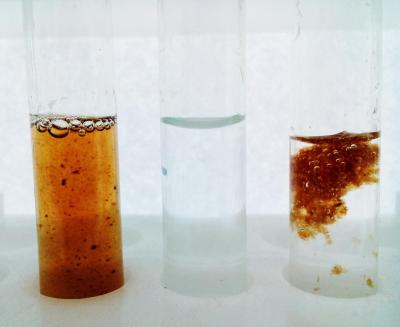Scientists from the National University of Science and Technology "MISIS" together with their colleagues from Derzhavin Tambov State University and Saratov Chernyshevsky State University have shown a way for graphene oxide to purify water, making it drinkable, without further chlorination. "Capturing" bacterial cells, it forms flakes that can be easily extracted from the water.
 1) Graphene oxide, added in water 2) Water after purification with graphene oxide 3) Graphene oxide 'flakes' with bacteria before extraction
1) Graphene oxide, added in water 2) Water after purification with graphene oxide 3) Graphene oxide 'flakes' with bacteria before extraction
The team has conducted an experiment, injecting graphene oxide into solutions (nutrient medium and the saline) containing E.coli. Under the terms of the experiment, saline "simulated" water, and the nutrient medium simulated human body medium. The results showed that the graphene oxide along with the living and the destroyed bacteria form flakes inside the solutions. The resulting mass can be easily extracted, making water almost completely free of bacteria. If the extracted mass is then treated with ultrasound, the graphene can be separated and reused.
"As working solutions, we chose a nutrient medium for the cultivation of bacteria (it is the natural habitat of bacteria), as well as ordinary saline, which is used for injections. As a tested bacterial culture, E. coli modified with a luminescent agent was used to facilitate visualization of the experiments, said Aleksandr Gusev, one of the authors and Associate Professor of NUST MISIS Department of Functional Nanosystems and High-Temperature Materials.
Graphene oxide was added to the nutrient solution in different concentrations - 0.0025 g/l, 0, 025 g/l, 0.25 g/l and 2.5 g/l. As it turned out, even at a minimum concentration of graphene oxide in saline (water), the observed antibacterial effect was significantly higher than in the nutrient medium (human body). Scientists believe that this indicates not a mechanical, but a biochemical nature of the mechanism of action, that is, since there are far fewer nutrients in the saline solution, the bacteria moved more actively and was "captured" by the scales of graphene oxide more often.
According to the fluorescent test data, confirmed by laser confocal microscopy and scanning electron microscopy, at 2.5 g/l concentration of graphene oxide, the number of bacteria decreased several times compared to the control group and became close to zero.
While it is not yet known exactly how the further destruction of bacteria occurs, researchers believe that graphene oxide provokes the formation of free radicals that are harmful to bacteria.
According to scientists, if such a purification system is used for water, it will be possible to avoid additional chlorination. There are other advantages: decontamination with graphene oxide has a low cost, in addition, this technology is easy to scale to the format of large urban wastewater treatment plants.


would it be safe to ingest?
If the graphene oxide makes it through the water treatment facility and into people's homes, would ingesting it in the water kill all the good bacteria in our guts that we need to properly break down foods and take in nutrients?
If it is not safe for the human body then scientists will need to re-think the statement that "it will be possible to avoid additional chlorination". Public water systems have to maintain chlorine levels in the water lines to protect against any possible contaminants that the water may come in to contact with after leaving their facility. Chlorine is good for this as in low concentrations, it is safe for human consumption.
That said, the medical industry should also be looking into this technology as graphene oxide antibiotics may prove quite effective.